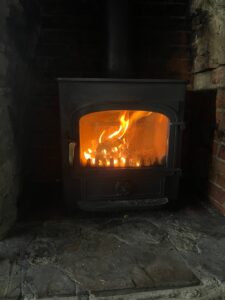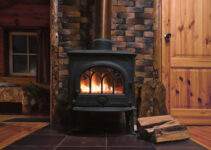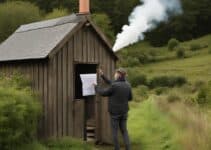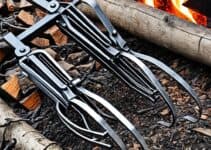When I decide on the heart of my home, the wood stove, I often ponder over the materials that best suit my need for cosiness and efficacy. My options narrow down to the classic cast iron stove or the sleeker steel stove, each boasting distinct qualities pertaining to heat retention amongst other factors.
Diving into the cast iron vs steel debate, I acknowledge that cast iron has been cherished for generations for its heat retention supremacy. The thick and dense construction of a cast iron wood stove may take a while to gather warmth but once there, it becomes a reservoir of heat, continuing to radiate long after the embers have waned. On the contrary, a steel wood burning stove responds with haste to the flames, providing immediate relief from the cold but cooling down just as swiftly when the fire dies.
Cast Iron vs Steel Log Burner Body: The Heat Retention Battle
As we delve into the discussion about the efficacy of various materials used for log burners, it becomes exceedingly pertinent to understand how the characteristics of cast iron and steel contribute to their heating performance. To many, the charm of a warm, glowing fireplace is more than just physical comfort—it’s about creating an ambience and the right choice of burner is central to this experience.
Understanding Heat Retention in Log Burners
Heat retention is the key to a log burner’s ability to provide continuous warmth. A material with superior heat retention characteristics will radiate warmth for an extended period, enhancing the log burner’s efficiency and the comfort of the environment. This prolongation of heat release is of particular consequence during colder nights when a consistent source of warmth becomes more than just a luxury.
The Impact of Material Density on Warmth Longevity
When comparing cast iron to steel log burner bodies, one must take into account the influence of material density on warmth longevity. The density of cast iron provides it with a considerable thermal mass, allowing it to absorb a greater amount of heat energy and releasing it slowly over time. This creates a reassuring, lingering sense of warmth that persists well after the flames have subsided.
| Feature | Cast Iron Log Burner | Steel Log Burner |
|---|---|---|
| Material Density | High | Lower than cast iron |
| Heat Retention | Excellent | Good |
| Warmth Longevity | Long-lasting | Decreases more rapidly |
| Response to Fire | Slow to heat, but retains heat longer | Heats up quickly, cools down faster |
In my assessment, the comparison between cast iron vs steel log burner bodies centres significantly on their respective abilities for heat retention and warmth longevity. While steel responds rapidly to heat and offers immediate comfort, cast iron makes up for its slower heating rate with its ability to retain warmth for substantially longer periods. It’s a log burner comparison where the choice hinges on balancing a desire for quick heat against the need for sustained warmth.
Exploring the Durability and Aesthetics of Cast Iron Log Burners
Having been a focal point in homes for generations, the cast iron log burner stands as a testament to enduring build quality and timeless design. When I consider the humble beginnings of casting iron, it amazes me how this ancient craft has continually evolved yet consistently provided homeowners with reliable heating solutions. The beauty and durability of the log burner have not only stood the test of time but have become emblematic of the classic wood-burning stove aesthetics so many seek.

An aspect I find particularly impressive is the casting process of these burners. Molten iron is poured into intricate moulds, setting the stage for a plethora of ornate patterns and designs that capture a certain rustic charisma. Unlike mass-produced items, each cast iron stove carries with it a character moulded by the intricate process of its creation. Such designs echo a tradition of craftsmanship that blends functionality with the artistry of a bygone era.
As a professional within the industry, I often encounter the misconception that cast iron is inherently brittle and prone to cracking. Such fallacies do little justice to a material that has shielded noble knights and constructed our greatest monuments. The reality is that cast iron log burners stand resilient against the test of time and heat. True, they require respect in handling and operation—avoiding overfilling and overheating—but given the proper care, they are incredibly enduring.
- Never overfire to avoid thermal shock
- Follow the burn rate as specified by the manufacturer
- Regularly inspect for any signs of wear or damage
- Use a stove thermometer to monitor temperature accurately
- Ensure professional installation
By adhering to these guidelines, I’ve maintained my own cast iron stove in pristine condition, proving that longevity is less about the material and more about the diligence of maintenance. It is because of such steadfastness that cast iron remains a material of choice for individuals seeking a balance of aesthetics and utility in their log burners.
For those with an appreciation of tradition and a penchant for performance, cast iron log burners offer an elegance that only improves with age, much like a finely crafted wine.
A Comparative Look at Steel Log Burners: Modern Design and Heat Dynamics
Embracing the sleek sophistication of a steel log burner manifests not just a nod to contemporary design but also to its ingenious heat distribution capabilities. I’ve discerned through practical experience and industry knowledge that such modern heating appliances have the prowess to cater to rapid warmth needs with remarkable efficiency. Herein, we shall delve into the dynamic functionality and aesthetic allure seamlessly encapsulated within these avant-garde steel stoves.
Assessing the Speed of Heat Distribution in Steel Stoves
The salient attribute of a steel stove is its dexterity in heat conveyance. Due to their thin, yet robust structure, these burners dispense heat expeditiously, swiftly transforming a chilly ambiance into a snug haven. The contrast in heat distribution speed when juxtaposed with their cast iron counterparts is conspicuous; steel log burners take the laurels for agility.
The Contemporary Appeal of Steel Log Burner Designs
My scrutiny of interior trends reveals a penchant for steel log burners that effuse a contemporary log burner body, aligning impeccably with modern interior décor. The manufacturing versatility of steel permits crafting shapes and silhouettes that are emblematic of the vanguard of fireplace fashion, distinctly favouring the minimalist proclivities of our epoch’s aesthetic sensibilities.
| Feature | Steel Log Burner | Cast Iron Log Burner |
|---|---|---|
| Design | Sleek, modern, adaptable to contemporary spaces | Ornate, classic, suited to traditional décor |
| Heat Up Time | Fast, responds quickly to demand for warmth | Gradual, with prolonged retention |
| Maintenance | Often requires less, due to simpler design | Consistent, based on structural intricacy |
| Material Thickness | Generally thinner, facilitating rapid heat output | Denser, accumulating and radiating persistent heat |
From the insights delineated in the table, it is palpable that the steel log burner offers an amalgamation of robust heat distribution and a modern design that endears itself to connoisseurs of fine living with a penchant for streamlined aesthetics. Their immediate warmth dispersal and sleek profiles paint a picture not just of a heating device but of an exquisite piece of functional art. Opting for a reputable brand hewn from high-grade steel and employing mindfulness in usage will fortify against potential warping, cementing these burners as a sagacious choice for the contemporary domicile.
Myths and Misconceptions: Cracking Cast Iron and Warping Steel
Delving into the world of wood stoves, there’s a rich lore of assumptions and tales about their materials—particularly cast iron and steel. I find myself coming across numerous customers harbouring the same uncertainties regarding these materials. It’s important to distinguish fact from fiction to make an enlightened decision when choosing the right stove.
Myth-Busting: The Reality of Cracking in Cast Iron Stoves
The endurance of cast iron stoves is lauded in the realms of both history and utility, yet they are sometimes wrongly accused of being fragile and prone to cracks. These cast iron stove myths run counter to my experience; the incidents of cracking are few and far between and often, stem from misuse rather than from any inherent flaw in the cast iron itself.
Addressing Concerns Over Steel Stove Warping
In a similar vein, steel log burner misconceptions are rife, with warping touted as a common issue. However, contemporary advancements in steel manufacture have significantly mitigated this risk. Steel stoves designed today, provided they are treated with due respect to operating instructions, demonstrate resilience against warping. It’s essential that maintenance, particularly of the firebricks—which act as a buffer to extreme heat—is upheld to ensure longevity.
| Myth | Reality | Preventative Measures |
|---|---|---|
| Cast iron stoves are prone to cracking | Cracking is rare and typically due to inappropriate fire management | Avoid over-firing and rapid temperature spikes to maintain structural integrity |
| Steel stoves warp easily | High-quality modern steel is robust against warping if used correctly | Maintain firebricks and adhere to manufacturer’s operational guidelines |
Are There Hybrid Options? The Best of Both Worlds
As someone deeply interested in the synthesis of form and function, I’m particularly fascinated by hybrid wood stoves, which marry the rapid warming qualities of a steel stove body with the enduring heat retention of cast iron doors. This ingenious combination addresses the dilemma for those who can’t decide between the two materials, offering a versatile stove design that accommodates both aesthetic tastes and heating preferences.
What captivates me most is how these hybrids are becoming a prominent choice for homeowners looking for efficiency without compromising on style. Below, I’ve outlined the key aspects that make hybrid stoves a compelling choice, reflecting both the warmth of tradition and the sleekness of modernity.
- Steel Stove Body – Known for its quick heat transmission, a hallmark feature offering timely comfort.
- Cast Iron Doors – Their substantial weight and material properties enable the stove to continue radiating heat, even as the embers die down.
- Versatile Stove Design – The hybrid wood stoves are designed to fit seamlessly within both rustic interiors and more contemporary spaces, making them universally appealing.
It doesn’t end there. Below is a comparison table that illustrates the blend of features these hybrid stoves offer:
| Feature | Advantage | Material |
|---|---|---|
| Rapid Heat-Up | Immediate ambiance and warmth upon lighting | Steel |
| Sustained Heat Distribution | Keeps rooms warm well after the fire has subsided | Cast Iron |
| Aesthetic Flexibility | Suits a variety of decor schemes; from vintage to modern | Hybrid |
| Durability | Long-lasting performance with proper maintenance | Hybrid |
In my professional view, what sets the hybrid design apart is not just the combination of materials but the way it encapsulates a holistic approach to home heating. It aligns with the growing desire for products that serve multiple purposes – in this case, a heat source that is both a functional fixture and a centrepiece for the home.
Shopping for Log Burners: Which Material Should Influence Your Purchase?
When embarking on the journey of log burner shopping, it’s not just the wood burning stove material that matters; it’s about identifying a stellar confluence of features that resonate with your lifestyle and domestic harmony. The purchasing considerations for a log burner transcend past the mere aesthetic allure or the primeval magnetism of the dancing flames; it extends into the realm of efficiency, harmony with your abode’s interior, and tailored heat output concomitant with the volume of your living space.
As someone passionate about assistive and strategic advice, I always posit to my readers that the choice of material—whether the venerable cast iron or the avant-garde steel—should serve as a piece of the puzzle, not the entire picture. After all, investing in a log burner is an affirmation of seeking comfort, ambience, and utility in one elegant hearthside addition to your home.
Consulting with a seasoned seller or exchanging notes with an experienced log burner user can glean you indispensable insights—those grounded in the realities of practical usage rather than the gloss of catalogues and showcases.
Furthermore, as we ponder the diverse array of options available during our log burner sojourn, let’s not elide the importance of sustainability and emissions, the type of fuel that will be predominantly used, nor the aspect of maintenance that comes with different materials.
- Efficiency: How well does the log burner convert fuel into heat?
- Aesthetics: Does the stove’s design complement your interior decor?
- Heat Output: Is the burner right-sized for your space?
- Fuel Type: Are you using seasoned wood, eco-friendly briquettes, or multi-fuel options?
- Maintenance: How much upkeep do the different materials demand?
Deliberation over such considerations ensures that your ultimate decision is bespoke to your individual requirements, rather than a generic repercussion of prevailing trends. Remember, whether you opt for a rugged cast iron edifice or a slender steel marvel, the paramount objective remains to endow your hearth with a companion that is as practical as it is enchanting.
Conclusion
Throughout this exploration of log burner materials, we’ve delved into the nuances of heat retention, design intricacies, and endurance of both cast iron and steel. Each material presents its own set of advantages and challenges, none of which should be overlooked when weighing up your options. Cast iron, for instance, exudes a timeless charm while providing a steady dissemination of heat long after the flames have subsided. However, its density means patience is required as it takes its time to gather heat. On the flip side, steel offers a modern look and a swift warmth distribution, favouring those chilly moments when immediacy is paramount – although it must be said, the warmth fades as quickly as it arrives.
Summarising the Pros and Cons
Steel versus cast iron pros and cons are often debated among enthusiasts and experts alike. Where cast iron asserts itself with prolonged heat retention and a nod to heritage design, it juxtaposes steel’s quick reaction time and sleek aesthetics. Durability also plays a crucial role; cast iron maintains its composure over time, while steel’s resilience relies on mindful use and maintenance. The log burner materials you choose must align with the rhythm of your lifestyle and the comfort of your living space.
My Final Thoughts on Log Burner Materials
In the glow of the embers, my final thoughts on wood stoves settle on the importance of informed choices. Consider beyond the mere material; scrutinise the stove’s efficiency, the craftsmanship behind it, and the assurances – the warranty that accompanies your selection. Your personal taste, coupled with the practicality of your space and heating desires, should steer your decision. Cast iron and steel both serve the purpose they were splendidly crafted for, but your unique circumstances will dictate which material becomes the hearth at the heart of your home.



